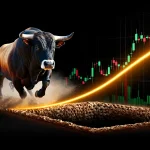What Is a Financial Bubble? Opportunity in the Making
Feb 14, 2025
Introduction: Profit Over Panic
Welcome to the unforgiving arena of modern finance, where fortunes are built or lost in the blink of an eye, and every decision carries the weight of a life‐or‐death battle. In this realm, one question stands as both a challenge and a clarion call: What Is a Financial Bubble? The rewards are legendary for those who possess the courage to see its formation coming. While the uninitiated panic and sell into the bottom, the wise and battle-tested investors seize earnings during the ascent and forge their futures when chaos reigns. This is not a guide for the timid. It is a manifesto for those who want to dominate the market with the precision of a master tactician and the elegance of a seasoned warrior-scholar.
The Anatomy of a Financial Bubble
A financial bubble emerges when exuberance and speculation detach asset prices from their intrinsic values. The bubble is not built overnight; it grows as a self-reinforcing cycle, propelled by mass optimism and the gravitational pull of herd mentality. Markets become arenas for unchecked euphoria, where rational analysis is overpowered by a rush of collective desire. Like an overstrained dam waiting to burst, the bubble expands until reality intervenes—a moment when economic fundamentals can no longer sustain the inflated valuations.
At its core, a financial bubble is a complex, dynamic system. It is a confluence of diverse elements that interact unpredictably: soaring media hype, innovative financial instruments, social contagion of emotions, and a deep-seated belief in endless growth. With each new participant and every dollar injected, the bubble swells further until it becomes an unsustainable fortress of hope and delusion. In these moments, investors who understand the underlying dynamics recognize that profits await those who arm themselves with foresight and discipline.
Mass Behavior and The Psychology of the Unsuspecting Masses
In a market bubble, collective euphoria drives prices skyward, detached from reality. The masses, seduced by quick gains and “must-have” assets, feed a loop of rising optimism. As more investors pile in, the illusion of endless prosperity intensifies, and emotions completely overshadow logic. But, amidst this chaos, a few savvy investors remain alert, knowing that every bubble has an expiration date. Their strategy? Profit during the ascent, then prepare to capitalize on the inevitable collapse.
The psychology of the masses during a bubble is simple: excitement clouds judgment, turning rational analysis into a mere afterthought. Investors, blinded by the crowd’s optimism, chase fleeting gains. Meanwhile, those with true market mastery maintain a clinical perspective, waiting for the subtle signs of reversal. When panic sets in, the few who stay steady are positioned to profit while others scramble to salvage their losses. The key to surviving and thriving in market euphoria lies in resisting the masses’ infectious optimism and sticking to strategic, disciplined decision-making.
Smart Investors: The Art of Early Profit
The truly intelligent investor never waits for the masses to act recklessly. Instead, they are relentless in their pursuit of foresight. They recognize that the apex of a bubble is not reached by those who blindly follow the crowd but by those who anticipate the turning point long before it becomes common knowledge. While many scramble to exit at the bottom of a falling market, these investors have already taken profits during the peak. They secure returns by selling into exuberance—a decisive action that demands courage and analytical rigour.
For the astute investor, taking money early is not synonymous with short-sightedness; it is a strategic manoeuvre honed by disciplined analysis and a deep understanding of market mechanics. When asset prices soar far beyond their intrinsic worth, it is a clear signal that the bubble is inflating to dangerous levels. Smart investors know that this is the ideal moment to lock in gains. They methodically trim their positions, capturing profits in stages to ensure maximum return without the risk of timing the final moment. Their measured exit strategy starkly contrasts the desperate panic of those who sell at the bottom, their actions governed by fear rather than strategy.
The Inevitable Burst: Mastering the Collapse
No financial bubble is eternal. The same forces that inflate a bubble—irrational exuberance, mass hysteria, and disconnect from fundamentals—set it up for a dramatic collapse. Even a minor trigger can ignite a chain reaction when prices soar far beyond intrinsic value. Panic spreads like wildfire, and the overinflated assets come crashing down, leaving wreckage and regret in their wake.
The prospect of a downturn doesn’t paralyze savvy investors; they plan for it. They compile meticulously curated lists of target stocks throughout the bubble’s ascent. Their strategy is ruthless yet precise: lock in profits early and stand ready to re-enter the market once the sentiment has fully reversed. By closely monitoring technical indicators, market sentiment, and the nuances of mass psychology, these investors know exactly when the tide is about to turn. When the dust settles, they re-enter with conviction, snapping up quality assets at a fraction of their previous prices. Their success hinges on the delicate balance of timely profit-taking and strategic reinvestment, transforming a volatile collapse into a prime opportunity.
You must deploy a sophisticated blend of technical analysis and sentiment monitoring to outsmart a bubble. The market is not a static, linear progression—it’s a dynamic, fractal organism where every data point is interconnected. Technical analysis serves as your compass in this chaos. Tools like the Relative Strength Index (RSI), moving averages, Fibonacci retracements, and Bollinger Bands help you gauge momentum, detect divergences between price and fundamentals, and identify overbought conditions. For instance, an RSI consistently above 70 signals that the market is teetering on the edge of unsustainable highs. Similarly, a divergence between rising prices and declining volume is a red flag that the bubble is nearing its zenith.
Simultaneously, sentiment analysis provides critical insights into the market’s emotional state. You can quantify the prevailing mood by aggregating real-time data from news outlets, social media, and trading forums—and processing it through natural language processing and machine learning algorithms. When euphoric overbuying is divorced from economic reality, it indicates that the bubble’s foundation is crumbling. Historical events, like the Dot Com bubble, demonstrate that when collective sentiment peaks, even the most robust stocks become vulnerable. The moment the crowd’s euphoria shifts into panic, a tipping point is reached, and the inevitable collapse begins.
Understanding mass psychology is crucial. The herd mentality drives investors to chase fleeting gains, often ignoring the underlying risks. In the height of a bubble, the market becomes a distorted mirror where emotion overrides logic. The reversal is rapid and brutal when the collective mindset turns from greed to fear. The key is to remain detached—recognize that the market is driven by human emotion, not immutable laws. By decoding these emotional currents, you can anticipate the shift from euphoric overbuying to desperate selling, positioning yourself to profit from the chaos.
Ultimately, mastering the collapse is about recognizing that every bubble has a breaking point. The moment when inflated prices meet reality is your signal: secure your profits and prepare to re-enter once the panic subsides. The disciplined few who can read both technical indicators and the subtle shifts in mass sentiment are the ones who turn market calamities into unprecedented opportunities.
When the bubble bursts, it isn’t the crash that defines you—it’s how you navigate the aftermath. By harnessing the dual powers of technical and sentiment analysis, you not only survive the collapse but emerge stronger, with a portfolio built on precision and resilience. In this ruthless arena, success is reserved for those who see through the smoke and mirrors, act with a seasoned warrior’s decisiveness, and transform market chaos into calculated triumph.
Tools of the Trade: Technical & Sentiment Analysis
Data is your most reliable weapon in the battle against market chaos. Advanced technical analysis and real-time sentiment evaluation form a formidable arsenal that cuts through the noise of irrational exuberance.
On the technical front, seasoned investors deploy time-tested indicators such as the Relative Strength Index (RSI), moving averages, Fibonacci retracements, and Bollinger Bands. These tools pinpoint price trends and signal potential reversal points. For example, an RSI reading above 70 often warns of overbought conditions, while moving averages help determine trending momentum and volatility. Fibonacci retracements highlight critical support and resistance levels, and Bollinger Bands measure market volatility. By setting precise thresholds for profit-taking, you can secure gains incrementally—selling portions of a position as the market nears unsustainable highs—thereby reducing overall risk exposure.
Meanwhile, sentiment analysis harnesses real-time data from news outlets, social media chatter, and trading forums to gauge the market’s emotional pulse. Utilizing natural language processing and machine learning algorithms, these tools quantify the tone and intensity of public discourse. Sharp spikes in bullish sentiment, especially when divorced from solid economic fundamentals, act as red flags. Historical evidence shows that the market is primed for a reversal when the crowd’s fervour reaches a fever pitch. This data-driven insight provides early warning signals—enabling you to exit positions before the inevitable collapse.
Together, technical and sentiment analysis create a robust, objective framework for decision-making. Without these tools, you’re flying blind in a storm of irrational exuberance. Use them to identify when the market is overheating, and the collective mood is dangerously skewed. This way, you turn raw data into a tactical advantage, positioning yourself to navigate market cycles with surgical precision.
Mastering Bubbles: Lessons, Tactical Reinvestment, and the Warrior Mindset
Bubbles always burst. The dot-com frenzy and the mid-2000s housing bubble prove that when irrational exuberance disconnects price from value, only the prepared profit. Savvy investors recognized this gap, secured gains early, and re-entered the market at bargain prices after the collapse.
When the bubble bursts, chaos becomes an opportunity. Tactical reinvestment is key: a curated list of target stocks combined with technical signals—oversold indicators, volume trends, momentum shifts—pinpoints the perfect moment to act. Amid widespread panic, the disciplined investor waits for sentiment to shift and fundamentals to reassert themselves, transitioning from defensive survival to aggressive buying.
This strategy’s core is the warrior mindset: unwavering discipline, relentless market insight, and the courage to act when others falter. Instead of succumbing to panic, the true master transforms adversity into an advantage by filtering out noise and focusing on structural signals.
By merging hard lessons from past bubbles, tactical reinvestment strategies, and the fierce warrior mindset, you build a blueprint for market success. When bubbles burst, only those who prepare will emerge unscathed and poised for the next wave of growth.
Conclusion
In the high-stakes battleground of modern finance, understanding and anticipating financial bubbles is not merely an academic exercise—it is a decisive factor in whether you win or lose in the market’s ruthless arena. What Is a Financial Bubble? Challenges every investor to confront the dual nature of market phenomena, combining periods of unsustainable exuberance with moments of stark, merciless correction.
Smart investors are those who defy the herd mentality. They bloodlessly secure profits during the ascent of the bubble, extracting gains early rather than being swept away by the madness that consumes the masses. When the bubble bursts—and it inevitably will—they stand ready with a prepared arsenal of target investments, methods to deploy capital at the opportune moment, and strategies forged through meticulous sentiment analysis, technical indicators, and mass psychology.
Their approach is as much an art as it is a science. It requires the relentless pursuit of data, advanced analytics, and mental discipline to differentiate between the illusion of endless prosperity and the reversion to economic fundamentals. In the face of the reckless optimism that pervades bubble markets, these investors maintain a resolute focus. With the precision of a skilled surgeon and the grace of a seasoned philosopher, they navigate the storm with an unbreakable will, knowing that the true profit lies in the ability to anticipate the collapse, secure gains early, and reinvest with deadly accuracy when the market’s sentiment turns.
The finance landscape is forever dynamic, influenced by the interplay of economic fundamentals, digital communications, and the psychological currents of its participants. In this ever-changing battlefield, knowing when to take defensive action and when to mount a counteroffensive can be the difference between triumph and catastrophe. With all its inherent peril, a financial bubble is also a crucible where the strong are tested and the prepared rise to claim their due.
Today’s market rewards the fearless—those who, against the tide of panic, choose to confront reality head-on, extract their winnings, and then re-enter the fray with unparalleled precision. This is the difference between the foolish masses, who sell at the bottom out of desperation, and the calculated investor, who turns chaos into an opportunity, reaping profits and forging a legacy from the ruins of inflated speculation.
Do not be seduced by the siren song of herd behaviour. Build your strategy on hard facts, advanced analytics, and a deep understanding of market psychology. Learn to harness the forces that create financial bubbles and use them to your advantage. The bubbles may burst, and the market may plunge, but with disciplined foresight and tactical acumen, these very moments become the sharp edge of your competitive advantage.
This is your arena. Arm yourself with relentless focus, measure every risk, and execute with the conviction of a warrior who has fought through the worst and emerged victorious. The question is not whether bubbles will form—it is whether you have the preparation and the warrior’s mindset to exploit them for legendary gains. Invest with class, precision, and an unyielding commitment to smart strategy, and remember: fortune favours those who see it coming.











